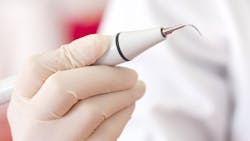When should you use the D4346 scaling procedure code?
In 2017, after several years of hard work by a dedicated group of dental hygienists, the American Dental Association’s Code Maintenance Committee voted to approve the procedure treatment code D4346—scaling in the presence of generalized moderate to severe inflammation—full mouth, after oral evaluation. Before the creation of this new procedure code, dental professionals were stuck with using either D1110/01120—prophylaxis—adult/child or D4341/D4342—periodontal scaling and root planing.
The D1110 code is a preventive procedure code that was designed for patients with good oral health or with localized areas of gingivitis. On the other hand, D4341/D4342 is a therapeutic procedure code for patients who require periodontal therapy to treat active periodontal disease, which includes bone loss and loss of attachment.
Filling a code gap
There was always a “gap” in the code set until D4346 was created. For patients who have more than localized gingivitis but don't have bone loss, D4346 does a great job of filling that gap. With the use of the new code, professionals are less likely to “undercode” by using a prophylaxis for the moderate to severe gingivitis patient or to “overcode” by using the periodontal therapy code when, in fact, the patient doesn’t have bone loss.
The ADA created a guide to using this new code, including a decision tree. Information from this document was used here.1
D4346 has no frequency limitations according to the descriptor: “It is indicated for patients who have swollen, inflamed gingiva, generalized suprabony pockets, and moderate to severe bleeding on probing.” The dental provider must determine when a patient is still in need of this therapeutic procedure vs. when they can return to a preventive prophylaxis procedure.
You might also be interested in: 2023 CDT code updates, and how to appeal a claim denial for SRP
You may be asking, does insurance cover this code? However, as is often the case, third-party payers may have coverage limitations or exclusions that will eliminate or limit reimbursements. Remember that just because their plan doesn’t cover the procedure, it doesn’t mean they don’t need the procedure. Dental benefit plans do not always cover everything that is needed to treat the patient. If a patient still presents with moderate to severe inflammation when they return, then D4346 is still the most accurate procedure code to continue to report, regardless of benefit coverage.
The ADA recommends that any claim using the D4346 procedure code should provide several pieces of information as supportive evidence. The first is full-mouth periodontal charting to include pocket depths, bleeding, and recession at the minimum. Clinical attachment loss is usually configured by the software once the probe depths and recession are charted. Radiographs showing bone levels of all teeth are also needed. The addition of intraoral photos is a wonderful way to show the amount of inflammation present. And, of course, clinical notes describing the diagnosis rendered should always be included as well.
We now have a way to accurately select the appropriate treatment for our patients who present with moderate to severe gingivitis based on their diagnosis. It is important that we perform our hygiene assessment, determine the diagnosis along with the dentist (if required), and then select the most appropriate procedure code for that diagnosis.
The foundation of the ADA when it comes to determining the correct CDT procedure code has always been “code for what you do” and “treatment planning is based on clinical need, not covered services.”2
References
1. ADA guide to reporting D4346. American Dental Association. January 1, 2023. https://www.ada.org/-/media/project/ada-organization/ada/ada-org/files/publications/cdt/v6_adaguidetoreportingd4346_2023jan.pdf
2. CDT 2023 Coding Companion. American Dental Association. 2023:16.
Editor's note: This article appeared in the August 2023 print edition of RDH magazine. Dental hygienists in North America are eligible for a complimentary print subscription. Sign up here.
About the Author

Kathy S. Forbes, BS, RDH, FADHA
Kathy S. Forbes, BS, RDH, FADHA, brings over four decades of passion and expertise to the dental profession as a clinician, educator, speaker, author, and consultant. Known for turning complex coding topics into clear, practical insights, Kathy helps dental teams connect accurate documentation and coding with quality patient care. Kathy serves as a Director for the DentalCodeology Consortium, where she works with hygienists from across the country to review and develop dental hygiene–related procedure codes and presents testimony annually to the ADA’s Code Maintenance Committee.
Reach her at [email protected].

Connie Simmons, MA, BSDH, RDH
Connie Simmons, MA, BSDH, RDH, earned her BSDH from The Ohio State University and her MA in aging studies from Wichita State University. She’s worked in clinical hygiene for almost 37 years and has other roles in clinical training, sales, speaking, and writing. Her knowledge of dental insurance and coding grew while working with an insurance carrier, and she’s now part of the Dental Codeology Consortium and an associate productivity coach with Inspired Hygiene. She’s also an expert in the clinical use of silver diamine fluoride. Reach her at [email protected].
